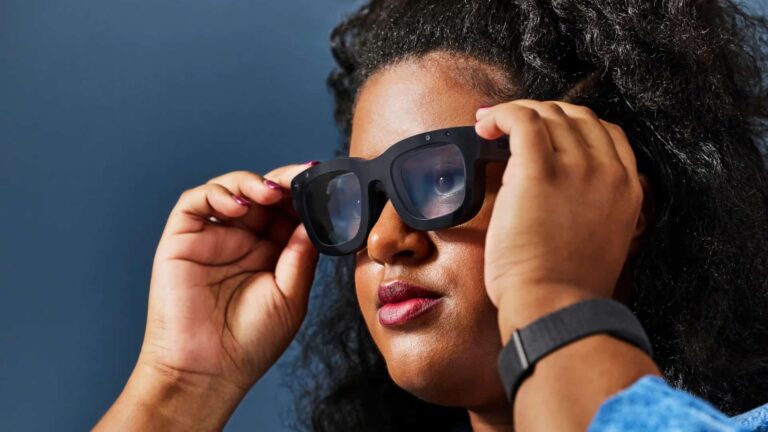
It’s been two weeks since Meta unveiled Orion from the Connect conference stage. There’s been lots of chatter and opinions, including the misguided view that it renders Vision Pro obsolete (more on that in a bit). But where does it fit in the AR device continuum and how does it advance AR?
In Orion’s same device class is Snap’s latest-generation Spectacles, which were unveiled just one week prior at Snap Partner Summit. In that light, Orion mostly outperforms Spectacles in specs and style… but it’s an apples-to-oranges comparison, which we’ll explore later in this article.
For now, it should be stated that Orion is a working prototype rather than a product with a foreseeable release date. Meta first must bring down the $10,000 bill of materials. That said, Orion can be reasonably described as the most advanced form of AR the world has yet seen.
We won’t list the specs as they’ve been well covered since Orion’s unveiling. Highlights include the device’s waveguide-based optical system with a micro-LED display and silicon-carbide lenses. That last part is the most expensive component and what enables Orion’s field of view.
We mention FOV because it’s perhaps Orion’s most noticeable UX attribute. At 70 degrees, it outmatches any AR headset on the market, and goes a long way in not breaking the illusion by cutting off digital objects at the margins. This is one reason Orion is so expensive to make.
Better Seen than Heard
As for intended use cases, though Orion is a prototype, its rigorous design was accomplished with specific AR activities in mind. These include holographic use cases as well as AI-based use cases. As we’ve examined, those two elements – visual AR and AI – elevate each other.
Taking those factors one at a time, holographic AR is the format that most people associate with AR. It’s the dimensional interactions of digital objects in physical space. This is AR’s holy grail, mostly held back by cost and device bulk. The latter is why Orion is a breakthrough at 98 grams.
As for AI use cases, these are already being test-marketed in a sense with Meta’s other AI wearable: Ray Ban Meta Smartglasses (MRBS). Those AI-driven activities include multimodal AI and audible utilities like live language translation or identifying objects in the real world.
Though the AR world pre-2024 has been obsessed with highly dimensional and immersive visual AR, it’s that AI-driven utility that’s taken over as a more realistic modality today. And that flavor of AR – which we sometimes call lite AR – enables hardware that’s thin & light, a la MRBS.
Back to Orion, when it’s ready for prime time, it will be lightweight enough to handle all those things, plus visual AR. The thought is that all those AI functions – though valuable now – gain dimension with visuals. Some things are better seen than heard (think: following a recipe).
Coexist vs. Converge
Though this device convergence could be the case for MRBS and Orion, Meta believes that Quest headsets and their passthrough AR capabilities will continue on their own evolutionary path. They – and Vision Pro for that matter – will live in the same world as seethrough AR glasses.
In other words, both device classes will advance in parallel, and coexist rather than converge. That’s because they address different use cases, personas, and situational contexts – the same way most people own a laptop and phone, instead of ditching both to do everything on a tablet.
As for those aligned use cases, passthrough AR performs better when it comes to lean-back entertainment, given its display performance, high contrast and full-pixel control. Seethrough AR meanwhile is more fitting to AR’s eventual holy grail – all-day wearable glasses.
Back to the apples-to-oranges comparison between Orion and Snap Spectacles. We say that because of Meta’s much bigger budget, and Orion’s prototype status. Both liberate Meta from some of the design restrictions placed on any margin-dependent and shipped tech product.
But the cost eventually must come down from $10k per unit. Though Quest headsets are known for loss-leader pricing, there’s a limit to how much money a device can lose… Or how much you can charge for it. It could take years for Orion to reach tenable levels on both measures.
Many Horses
As that cost-cutting process unfolds, the eventual device will look different than today’s Orion prototype. Meta tells the Verge that the goals are to get higher resolution, higher brightness, and lower cost. It will also ditch the silicon carbide lenses and the lauded 70-degree field of view.
Those measures will achieve lower cost and about half the weight, which brings them into “all-day wearable” territory. To that end, a related goal is making Orion function as regular and unobtrusive glasses when they’re turned off – an often-underrated design target for AR.
But the underlying point here is that the glasses that Meta showed the world – though a feat of engineering to be celebrated – are not what we’ll end up with. That should be remembered by anyone calling Orion a Vision Pro killer. One device is available today. The other is not.
In fairness, though Orion is a prototype, Meta gets points for investing billions to accelerate AR’s future; and giving us a glimpse of what it could look like. Meanwhile, Ray-Ban Meta Smartglasses are here today in the lite-AR camp. This lets Meta cover both ends of the AR spectrum.
Somewhere between those endpoints are Quest 3 and 3S, including passthrough AR functionality. Altogether, Meta is betting on many horses and timelines. It’s achieving realistic XR products today, while developing the right muscles to battle in tomorrow’s competitive landscape.

